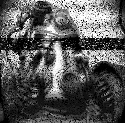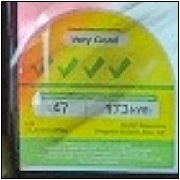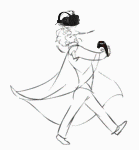|
Gimperial posted:https://arstechnica.com/gadgets/2015/02/pono-player-review-a-tall-refreshing-drink-of-snake-oil/ quote:Considering Pono's firm sales pitch about us needing the highest-res audio available, we were surprised to not find any "highest resolution only" filter in its internal storefront. This is where Pono's snake oil really begins, because when you play any 192/24 songs on the player, it rewards you by—we're not kidding—turning on a little blue neon light. This doesn't happen if your 192/24 songs didn't come from Pono's storefront, however, as those are apparently not 192 enough.
|
|
|
|

|
| # ? Apr 24, 2024 18:28 |
|
Gimperial posted:https://arstechnica.com/gadgets/2015/02/pono-player-review-a-tall-refreshing-drink-of-snake-oil/ Conclusion: Get a Clip or Fiio X1
|
|
|
|
grack posted:Conclusion: Get a Clip or Fiio X1 I have been thoroughly satisfied with my Clip Zip with Rockbox installed, but most of the time I just use my phone, because it's a lot more convenient.
|
|
|
|
Use your phone you idiots.
|
|
|
|
Head-Fi seems to be impressed by the WCD93x0 DAC from Qualcomm, IIRC, which they use in their Snapdragon SoCs. So yeah, use your drat phones.
|
|
|
|
Hey, I definitely use my phone for listening, but there is still a niche for standalone players.
|
|
|
|
Yea, for idiots.
|
|
|
The Devil Tesla posted:Yea, for idiots. The niche isn't "my sound quality!" it's "I don't want a 5.5"+ smartphone bouncing around in my pocket while I jog." But yeah, the bottom of this page has a chart of RMAA results for current gen Android phones. iPhones are just as good. Use your drat phone.
|
|
|
|
|
Theris posted:The niche isn't "my sound quality!" it's "I don't want a 5.5"+ smartphone bouncing around in my pocket while I jog." Or "I don't want to use up all the battery on my phone".
|
|
|
|
Or people who don't like ipods.
|
|
|
|
In my case it's that my next car is still five or six years off, and my current car supports an iPod in the glove compartment, or a couple SD cards that for no good reason are limited to 3000 tracks total.
|
|
|
|
I bought the Sansa Clip+ as a reference DAC. poo poo, I'm getting the audiophile bug.
|
|
|
|
After laughing over the pono and doing more reading, can someone help me understand how you rate an audio format's dynamic range? For instance, according to this image 16-bit 44.1 kHz has a Dynamic Range of 96dB. But I thought dynamic range was just the measurement of someone's ability to detect audio. And since you can amplify sound and music files, how does a dynamic range even exist? I am just really confused by the idea of Dynamic Range, even after sifting through the whole wiki. Also, I am assuming that in PCM audio the bit depth determines the frequency range, correct?
|
|
|
|
Knifegrab posted:After laughing over the pono and doing more reading, can someone help me understand how you rate an audio format's dynamic range? For instance, according to this image 16-bit 44.1 kHz has a Dynamic Range of 96dB. But I thought dynamic range was just the measurement of someone's ability to detect audio. And since you can amplify sound and music files, how does a dynamic range even exist? I am just really confused by the idea of Dynamic Range, even after sifting through the whole wiki. Bit depth determines dynamic range. Nyquist frequency determines frequency range. I think you're confused at the concept of a decibel. A decibel is a ratio, not an absolute measurement on its own. So turning up the volume doesn't change the dynamic range, because the ratio of loud stuff to quiet stuff stays the same. This is confusing, because SPL (Sound Pressure Level) is measured in decibels, but IS an absolute measurement because 0dB SPL is a defined point (20 micropascals - roughly the quietest thing a human can typically hear). When measuring volume, you use dB SPL and when measuring dynamic range, you just use dB. "Reference volume" is when dB = dB SPL. All of this is a long winded way of saying that 16-bit audio at reference volume can produce sounds that are dangerous to your hearing AND sounds that are barely on the threshold of human perception - at the same time. meaning more dynamic range is loving stupid. Hope that helps. Edit: For the pedantic, 24-bit audio support isn't totally stupid because it gives 8 bits of digital volume adjustment without affecting the dynamic range of 16-bit content. On the other hand, setting your volume to -10dB SPL is going to make sounds <10dB too quiet to hear so you won't really miss the dynamic range, anyways. That and 99.999% of content doesn't use even a fraction of the dynamic range available. 
KillHour fucked around with this message at 01:21 on Feb 5, 2015 |
|
|
|
Knifegrab posted:After laughing over the pono and doing more reading, can someone help me understand how you rate an audio format's dynamic range? For instance, according to this image 16-bit 44.1 kHz has a Dynamic Range of 96dB. But I thought dynamic range was just the measurement of someone's ability to detect audio. And since you can amplify sound and music files, how does a dynamic range even exist? I am just really confused by the idea of Dynamic Range, even after sifting through the whole wiki. beaten but, The dynamic range is a ratio of the difference in magnitude between the largest signal and smallest signal. In a detector, that ratio is between the biggest thing it can detect and the smallest. In digital audio, it is the ratio between the biggest signal that can be represented by the format and the smallest. For binary integers, 8-bit can have 255 non-zero values, 16-bit can have 65535 values, a 24-bit signal 16.7 million. So the ratio of the biggest to smallest value in 16-bit is 65535:1. You can find the dynamic range in dB by 20*log10(2^bitdepth-1). More bits means a larger dynamic range. The sampling frequency is what determines the frequency range. Part of making a signal digital is taking a reading every so often. This is called sampling. Because the data is sampled, there is a limit to what we can accurately represent. There is a sampling theorem that says that you need to sample twice as fast as the fastest frequency you are interested in. So, if you sample at 44.1kHz, you could represent, at best, a 22.05kHz signal accurately.
|
|
|
|
taqueso posted:beaten but, To expand on this a little bit (because a LOT of audiophiles get hung up on the sampling thing), when we say accurately, we mean identical. You only need 2 points of a sine curve within a single period to define it. Since all sounds are multiple sine curves laid on top of each other, a 44kHz sample can reproduce all sounds 22kHz or less. http://en.wikipedia.org/wiki/Nyquist_frequency KillHour fucked around with this message at 01:32 on Feb 5, 2015 |
|
|
|
^^ Between the two of you that has to be to most succinct and accessible explanation of bit depth, sampling and dB I've seen. Kudos.
|
|
|
|
I just want to make sure I understand this by explaining it in laymans terms. The bit depth determines the number of intensity intervals, or that is to say, a higher bit depth means there can be a greater difference between the quietest something can be loudest it can be. The sampling frequency determines the range of frequencies a sound file can output. So a sampling frequency of 400 Hz will create a sound file that can only output 200 Hz max, or that is to say, very low tones. And because human hearing upper limit is around 20kHz, anything above a samplying rate of 40kHz is essentially pointless correct? Also was the dynamic range expressed in dB for the express purpose of being used in conjunction with reference volume?
|
|
|
|
Knifegrab posted:I just want to make sure I understand this by explaining it in laymans terms. This is correct. The reason dynamic range is expressed in decibels is because dB is the standard logarithmic scale used for scientific measurements (logarithmic meaning it's not linear - 3dB is 2x as much as 0dB; 10dB is 10x as much as 0dB; 20dB is 10x as much as 10dB). http://en.wikipedia.org/wiki/Decibel
|
|
|
|
Knifegrab posted:I just want to make sure I understand this by explaining it in laymans terms. quote:The sampling frequency determines the range of frequencies a sound file can output. So a sampling frequency of 400 Hz will create a sound file that can only output 200 Hz max, or that is to say, very low tones. quote:Also was the dynamic range expressed in dB for the express purpose of being used in conjunction with reference volume? dB is a good way to express a ratio that can be very large, so it gets used for a lot of things. This wikipedia page has a whole bunch taqueso fucked around with this message at 02:47 on Feb 5, 2015 |
|
|
|
taqueso posted:That is the claim. The counter-claim is that sounds above 20kHz influence our sensing of the audio even though we have a difficult time picking out those frequencies in a hearing test environment. I'm skeptical, but the only downsides to a faster sampling rate are increased processing overhead and larger filesize. Which are almost free these days, so go for IMO. This is not true. Sounds over 22khz played through many systems can cause audible aliasing or harmonics (which are bad).
|
|
|
|
KillHour posted:This is not true. Sounds over 22khz played through many systems can cause audible aliasing or harmonics (which are bad). Yeah, I suppose so and maybe even likely on an average setup. I meant more 'it isn't worse as a technology', and didn't mean to imply that it would always be better in practice. I can see how what I wrote could easily be taken that way.
|
|
|
|
I've been reading Archimago's blog and found it very interesting. He does some of the tests that normal reasonable people would find completely superfluous, such as whether TOSLINK cables have an audible difference on the analog output (they don't): http://archimago.blogspot.ca/2013/05/measurements-toslink-optical-audio.html He's also done a similar test on analog RCA cables, showing that there is a very very slight measurable difference, which is probably mostly caused by cable length: http://archimago.blogspot.ca/2013/05/measurements-analogue-rca-interconnects.html There are a bunch of other similar measurements on his blog, as well as a handful of rants on Pono and that sort of thing. E: We've had plenty of bullshit graphs before, but this one takes the cake:  If you're a dolphin, CD is A-OK! KozmoNaut fucked around with this message at 11:36 on Feb 5, 2015 |
|
|
|
KillHour posted:This is not true. Sounds over 22khz played through many systems can cause audible aliasing or harmonics (which are bad). What are these? Also at what point is dithering virtually undetectable? If my understanding is correct, the lower the bit-depth, the more drastically a sound will be dithered, correct?
|
|
|
|
Knifegrab posted:What are these? 22 khz sampling at 16 bit, which is effectively half of CD, was good enough for in-game music in a lot of 90s video games and the effect was mostly noticeable only with tracks with a lot of high sounds. 8 bit sampling at 8 khz is of course what a standard landline uses, though in that case a lot of the effect also comes from everything over 4khz being cut out.
|
|
|
|
Knifegrab posted:What are these? There is a (very severe) example on Wikipedia. If you try to encode a signal that is above the Nyquist frequency, you get all kinds of junk below that frequency instead. That's aliasing. It can happen when your equipment is not able to deal with the super-high frequencies. Some tweeters will have all kinds of audible effects if you feed them higher frequencies than they were designed for, because you're exciting their resonant modes. Similarly, harmonics are the frequencies that make sounds differ from pure sine waves when layered on top of the base frequency. Ultrasonic frequencies can have harmonic frequencies in the audible frequency range. So while ultrasonic noise is inaudible, it can have audible effects that get in the way of the actual signal. quote:Also at what point is dithering virtually undetectable? If my understanding is correct, the lower the bit-depth, the more drastically a sound will be dithered, correct? Dithering is a good thing, since it can mask quantization noise. Again, Wikipedia has an example: https://en.wikipedia.org/wiki/File:16bit_sine.ogg https://en.wikipedia.org/wiki/File:6bit_sine_truncated.ogg The second sample was reduced from 16-bit to 6-bit with no dithering of any kind. You can easily hear the noise when compared to the original. What dithering does is "smooth out" the signal to reduce that noise, which comes from mapping a number of discrete values down to a smaller number of possible discrete values, thus decreasing the accuracy of the signal. The brilliant thing is that dithering actually reduces audible noise by adding noise to the original signal, before it is reduced in bitrate. It replaces the offensive-sounding noise with noise that is less objectionable, while allowing the signal to be reduced in bitrate more accurately. Noise-shaped dither is even cooler, since it moves the noise into the higher frequencies where human hearing is less sensitive. That way, you can in fact get a noise floor that is effectively lower than what the format is capable of if you simply calculated it directly. 16-bit audio is good for ~96 dB of dynamic range, strictly by the numbers. With good noise-shaped dither, upwards of 110-115 dB is possible, and you can actually make out sound below the noise floor. It's properly amazing stuff. Any release that is mastered as 24-bit audio (99,999%) will be dithered when converted to 16-bit, mostly just to be on the safe side. The quantization noise floor is usually way way below the actual noise floor of the recording, due to the inherent noise from microphones and so on. It's only when you get into lower bitrates that it really starts to come into effect, like in the examples above. KozmoNaut fucked around with this message at 19:38 on Feb 5, 2015 |
|
|
|
KozmoNaut posted:
What. Is this trying to claim that CDs sound worse than 96k audio? WHAT.
|
|
|
|
Scuba diving is cooler than snorkelling. Also Pono is Icarus. A good infographic!
|
|
|
|
SuperDucky posted:What. Is this trying to claim that CDs sound worse than 96k audio? WHAT.
|
|
|
|
That makes my brain hurt less, thanks.
|
|
|
|
SuperDucky posted:That makes my brain hurt less, thanks. It shouldn't.
|
|
|
|
KozmoNaut posted:There is a (very severe) example on Wikipedia.
|
|
|
|
Zemyla posted:Dithering also helps people with strokes and diabetes keep their balance by raising signals above the detection threshold of their nerves. It's really cool. That is a very creative and totally awesome use of technology  I completely forgot that Monty Montgomery actually covered dithering and noise shaping in his video on digital audio: https://www.xiph.org/video/vid2.shtml
|
|
|
|
KozmoNaut posted:E: We've had plenty of bullshit graphs before, but this one takes the cake: Pretty sure those are not seagulls but bats to be able to hear 192 khz.
|
|
|
|
baka kaba posted:Scuba diving is cooler than snorkelling. Also Pono is Icarus. A good infographic! Icarus? I thought the pono dude has giant dongs and balls on his shoulders 
|
|
|
|
Ordered 3 Monoprice cables for every 2 I need for a project to appease someone above me who is concerned about cable quality. I'll be testing every full system before I install it anyway. In addition to cost savings, Redmere cables are a hell of a lot easier to route through equipment racks than standard thickness HDMI cables. Overall savings $6300. When the next upgrade cycle comes around next year, I'll be sure to point out that I don't need any extras because the ones from this round of upgrades all worked. So far at work I've ordered 4000-5000 cables from Monoprice and had one defect and one go bad in the field. GWBBQ fucked around with this message at 01:30 on Feb 9, 2015 |
|
|
|
It's hidden somewhere in the wayback machine but there's some guys that took an official Dolby digital analyzer [like a $300k piece of equipment] and did a bunch of digital coax cable tests including using a wire hanger and they all passed 100%. It's like jitter, network dropouts and other things audiophiles like to spend tens of thousands of dollars to solve, if there's something wrong you'll notice right away.
|
|
|
|
Remember when Audiophiles used to argue about what was the best quality CD-Rs? "My favorites: Maxell 80 Minute Pro (blue) for solid robust low end, detail and clean immediacy; Maxell Music 80 minute gold for a balanced hight-to-mid-to-bottom and wide sparkle; Fuji 80 Minute Audio for a wetter sound (smoothes out the edges). Memorex Music 80 minutes is very nice, Taiyo Yuden 700 MB are close, the Mitsui and BASF are in there, Sony could be better..."
|
|
|
|
Nintendo Kid posted:Remember when Audiophiles used to argue about what was the best quality CD-Rs? So do they record everything three times in order to get the full musical experience?
|
|
|
|

|
| # ? Apr 24, 2024 18:28 |
|
And at 2x
|
|
|















































